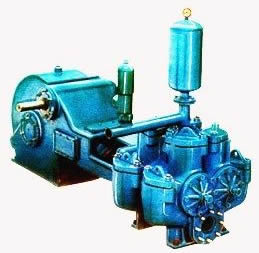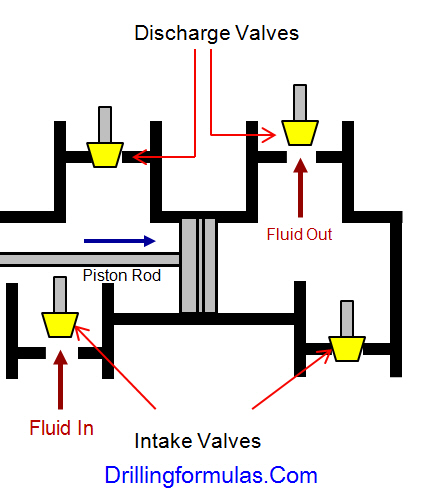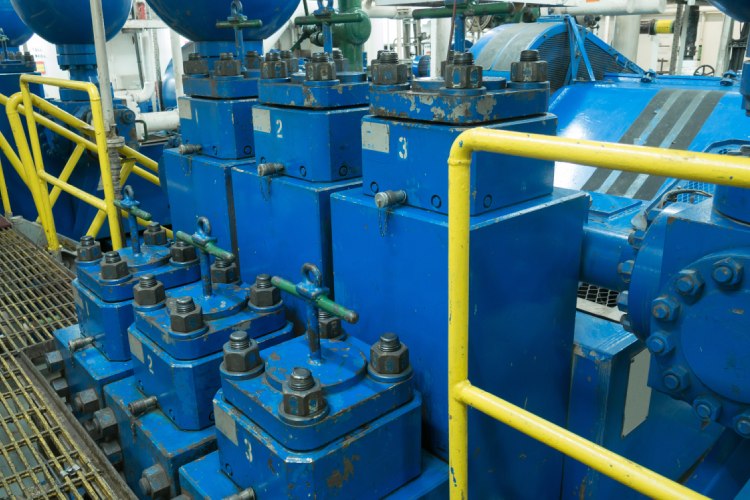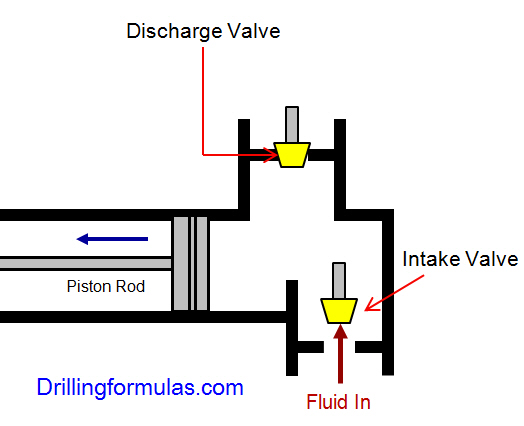Positive displacements pumps are generally used on drilling rigs to pump high pressure and high volume of drilling fluids throughout a drilling system. There are several reasons why the positive displacement mud pumps are used on the rigs.
• The pumps can work with fluids with high solid content.
• There are wide ranges for pressure and flow rate.
• They are more reliable and able to pump at tough conditions.
• They are easy to operate and maintain.
Duplex and Triplex pumps are positive displacement pumps which are commonly used in the oilfield.
Duplex Pumps – 2 cylinders, double acting

Figure 1 – Duplex Pump
The duplex pumps (Figure 1) have two cylinders with double acting. It means that pistons move back and take in drilling mud through open intake valve and other sides of the same pistons, the pistons push mud out through the discharge valves.
The following diagrams demonstrate how duplex mud pumps work.

Figure 2 – Position of Piston Rod and Fluid Movement of Duplex Pump
When the piston rod is moved forward, one of intake valves is lift to allow fluid to come in and one of the discharge valve is pushed up therefore the drilling mud is pumped out of the pump (Figure 2).

Figure 3 -Position of Piston Rod and Fluid Movement of Duplex Pump
On the other hand, when the piston rod is moved backward drilling fluid is still pumped. The other intake and discharge valve will be opened (Figure 3).
Triplex Pumps – 3 cylinders, single acting
The triplex pumps have three cylinders with single acting. The pistons are moved back and pull in drilling mud through open intake valves. When the pistons are moved forward and the drilling fluid is pushed out through open discharge valves.

Figure 4 Triplex Pump
The following diagrams demonstrate how the triplex mud pumps work.
Each diagram shows the action of one cylinder.

Figure 5 – Position of Piston Rod and Fluid Movement of Triplex Pump (Discharge)
When the piston rods are moved forward, the intake valves are in close position and the discharge valves are in open position allowing fluid to discharge (Figure 5).

Figure 6 Position of Piston Rod and Fluid Movement of Triplex Pump (Suction)
On the contrary when the piston rods are moved backward, the intake valve are opened allowing drilling fluid coming into the pump (Figure 6). This video below shows how a triplex mud pump works.
Which one is the most practical mud pump on the rig nowadays?
Triplex pumps are more popular than duplex pumps because of being lighter, smoother discharge and lower maintenance cost.
Calculations Related to Positive Displacement Mud Pumps
Hydraulic Horse Power (HPP)
Hydraulic Horse Power (HPP) formula is listed blow
HHP= (P x Q) ÷1714
Where;
HHP = hydraulic horsepower
P = circulating pressure, psi
Q = circulating rate, gpm
Because each pump has power rating limit as 1600 hp, this will limit capability of pump. It means that you cannot pump at high rate and high pressure over what the pump can do. Use of a small liner will increase discharge pressure however the flow rate is reduces. Conversely, if a bigger liner is used to deliver more flow rate, maximum pump pressure will decrease.
The figure 7 below shows the performance of mud pump National 12-P-160 TRIPLEX MUD PUMP.

Figure 7 – Pump Performance Chart
As you can see, you can have 7500 psi with 4.5” liner but the maximum flow rate is only 297 GPM. If the biggest size of liner (7.25”) is used, the pump pressure is only 3200 psi.
Triplex Pump Output Formula
Triplex Pump Output in bbl/stk = 0.000243 × (liner diameter in inch) 2 ×(stroke length in inch)
Duplex Pump Output Formula
Duplex Pump Output in bbl/stk = 0.000162 × S × [2(D)2 – d2]
Where:
D = liner diameter in inch
S = stroke length in inch
d = rod diameter in inch
These formulas are based on 100% efficiency.
The actual pump output must be considered pump efficiency.
Finally, we hope that this article would give you more understanding about the general idea of drilling mud pumps. Please feel free to add more comments.
Ref Article : https://www.drillingformulas.com/pump-output-calculation-for-duplex-pump-and-triplex-pump/








Thank you very much. Your articales alwyas help. Thanks Again.
Nice topic
very good very useful ..will be more advantageous if in HD
thankyou
Its a good comprehensive topic you share it,
Thanks Man